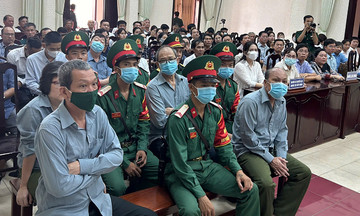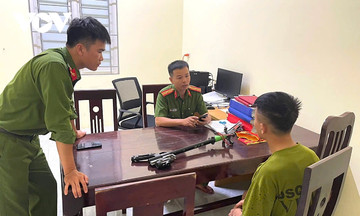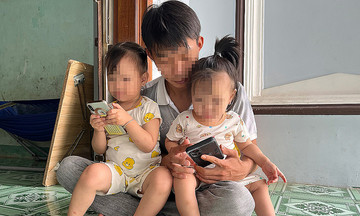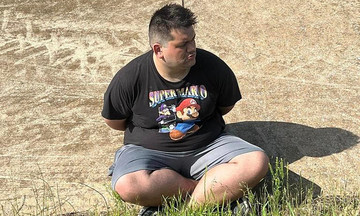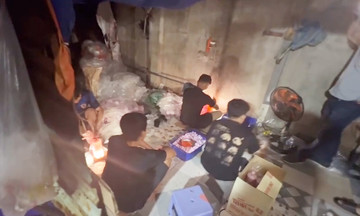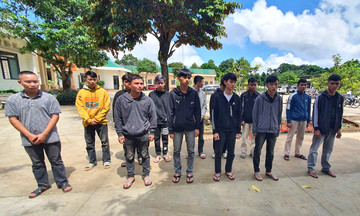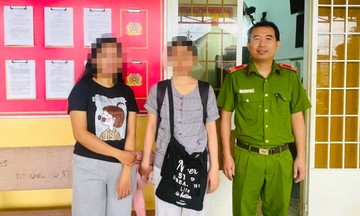On 17/9, 67-year-old Ly Quang Hoa stood trial in the Hanoi People's Court, accused of murder in a case dating back 40 years.
The first trial, held in May, resulted in the case being returned for further investigation. The court requested additional witness testimony to clarify the defendant's actions and the victim's cause of death.
The Hanoi People's Procuracy determined that due to the passage of time, many witnesses were either deceased or had moved, making it impossible to obtain further testimony. Consequently, the indictment remained unchanged for this second trial.
The case originated on 26/11/1985 at 5 PM. Two students, aged 18 and 19, from the Central Propaganda School (located in Cau Giay, Hanoi) went to buy fish at Dich Vong Green Market. They decided not to purchase the fish due to the high price, which led to an argument and a physical altercation with the fishmonger.
The fishmonger, wielding a scale and chair, attacked the students. One of the students managed to disarm her and retaliated. The fishmonger’s brother-in-law, a war veteran, then joined the fray, attacking the students with a carrying pole.
Hoa, then 17, was helping his mother at a nearby stall. Seeing the commotion, he intervened, telling the students not to attack the war veteran, and then joined the fight against the students.
According to the procuracy, the two students returned to their school and gathered a group of classmates for support. They then returned to Green Market and caused damage to stalls, injuring Hoa's mother.
Hoa ran home and told his younger brother about their mother's injuries. The two brothers armed themselves with broken chair legs and went to the alley entrance where they encountered a group of more than 10 students.
During the ensuing fight, Hoa swung a wooden stick, striking Tran Nam Trung, one of the students, in the head. Trung died 10 days later.
Hoa fled the area, living as a transient for years while being wanted by authorities. On 1/5/2024, he returned to Hanoi and surrendered to the police. He is currently in custody.
"I would have been the one who died if I hadn't fought back."
Throughout both trials, Hoa maintained his innocence. He testified that he intervened in the initial altercation to protect a woman and a war veteran from two young men who then attacked him. He denied the prosecution’s claim that he joined in the assault.
Hoa stated that he was unarmed and only pushed the two men away before fleeing home. He said nearly 20 students chased him to his alley. Outnumbered, he and his brother grabbed wooden sticks (broken chair legs) and fought back in self-defense, fearing for their lives.
Hoa said he ran away after the fight, wandering for days and eventually leaving the area. He insisted that no one had fallen to the ground when he fled and that he did not kill anyone.
A witness, who was playing badminton with Hoa’s younger brother at the time, corroborated Hoa’s account of being chased. "I didn't see Hoa holding anything or attacking anyone, just a large group of people chasing each other. Afterward, I didn't see anyone lying on the ground," the witness testified.
Minh, Hoa's brother, testified that he saw Hoa run home "covered in blood and with torn clothes." Minh grabbed a wooden stick for protection but did not hit anyone. He saw Hoa with a stick, but stated that Hoa could not have effectively attacked anyone due to being severely outnumbered.
Minh said only he and his brother were initially involved in the altercation, but villagers later joined the fray. He suggested that "someone else could have caused the victim's death" due to the large crowd, which "blocked the road from Dich Vong to Cau Dien".
The victim’s sister, present in court, stated that her family lived in Ha Tinh and had no firsthand knowledge of the fight. They were only informed of her brother’s death and burial at Van Dien Cemetery. Three years later, they brought his remains back to their hometown.
After questioning, the prosecution argued there was sufficient evidence to convict Hoa, recommending a sentence of 9 to 11 years in prison.
Victim's 10-day hospitalization lacks medical records.
Defending Hoa, lawyer Bui Thi Kim Lien argued that despite 110 additional documents added after the first trial, key issues remained unresolved.
The lawyer pointed out that despite the victim's 10-day hospitalization, the case file contained no medical records or documentation. However, there were two "forensic examination reports," both numbered 4234, with discrepancies.
One report described the victim's injuries but lacked any signatures. The other, with the correct name "Trung," had incorrect dates for the emergency surgery and death.
According to Lien, these hospital documents were crucial to determine when the victim was admitted, any pre-existing conditions, and the cause of death. Furthermore, there was no documentation of an autopsy, examination of wounds, or analysis of evidence to determine the cause of death.
"On what basis can Mr. Hoa be accused of directly causing the victim's death by fracturing his skull?", the lawyer argued.
The lawyer noted the lack of crime scene investigation or reenactment. Despite conflicting witness testimonies, no cross-examination was conducted.
The lawyer also highlighted that Hoa’s family home was burned down on the day of the incident. The arson was attributed to the group of students, but the case file contained no conclusive investigation identifying the perpetrators.
Inconsistencies also existed regarding the victim’s identity. The former Tu Liem District Police confirmed a student matching the description attended the Propaganda School. However, the victim’s local commune police had no record of him, and the agency that allegedly sent him to school reported no information about him in their archives.
Based on this analysis, lawyer Bui Thi Kim Lien requested the court to return the case for further investigation and to appoint a new investigator.
After deliberation, the court returned the case for further investigation to confirm the victim's identity and other details.
Thanh Lam



